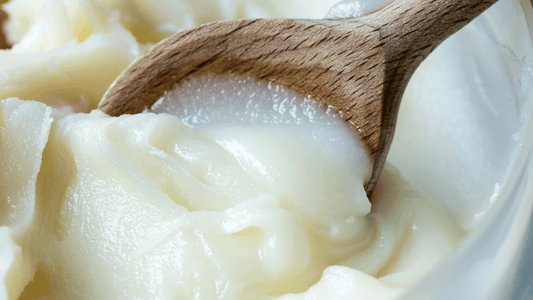
HOW TO PURIFY TALLOW
Share
How to Purify Tallow for Natural Skincare and Culinary Use
Tallow has made a powerful comeback in both skincare and culinary worlds thanks to its natural, nutrient-dense composition. But before tallow can be transformed into creamy balms, nourishing soaps, or used as a healthy fat for cooking, it needs to be purified properly. Whether you're a DIY enthusiast looking to make your own skincare products or someone interested in ancestral cooking practices, learning how to purify tallow is essential.
In this guide, we’ll walk you through the process of purifying tallow step-by-step, explain why purification matters, and give tips for ensuring the cleanest, odorless final product. Ready to elevate your tallow game? Let’s get started.
Why You Need to Learn How to Purify Tallow
Raw tallow, which is rendered beef fat, often contains impurities such as blood, connective tissue, and bits of meat. If not properly purified, these contaminants can lead to an unpleasant smell, poor texture, and shortened shelf life. That’s why understanding how to purify tallow is more than just a helpful skill—it’s a crucial step in creating a high-quality final product.
Whether your end goal is a luxurious tallow balm or a healthy cooking fat, purification enhances:
-
Shelf stability: Removing impurities keeps the tallow from going rancid quickly.
-
Texture and color: Pure tallow is creamy white with a smooth consistency.
-
Scent: Purified tallow has a very mild, almost neutral scent, perfect for skincare use.
How to Purify Tallow: Step-by-Step Process
Purifying tallow doesn’t require fancy equipment—just some basic kitchen tools and a bit of patience. Here’s a detailed guide on how to purify tallow for both skincare and food-grade use:
Step 1: Source High-Quality Beef Fat
Look for suet, which is the hard fat from around the kidneys and loins of cows. It’s cleaner and more nutrient-dense than other body fat. Visit a local butcher or farmer for grass-fed, organic fat whenever possible.
Step 2: Chop and Render the Fat
-
Cut the fat into small pieces or grind it using a meat grinder.
-
Place the fat in a large pot or slow cooker.
-
Add about 1 cup of water per 5 lbs of fat to prevent burning.
-
Slowly heat on low, stirring occasionally, until the fat fully melts. This can take 2–4 hours.
Step 3: Strain the Tallow
Once the fat is completely melted, you'll notice browned bits (cracklings) floating in the liquid. Use a fine mesh strainer or cheesecloth to strain out the solids.
Step 4: Water Washing (The Key to Purification)
This is the real secret in how to purify tallow like a pro.
-
Pour the strained liquid tallow into a large bowl or pot.
-
Add an equal amount of boiling water.
-
Stir thoroughly, then allow the mixture to cool and separate. The tallow will harden on top, and water (with impurities) will sink to the bottom.
-
Once cooled, remove the hardened tallow and discard the water underneath.
-
Repeat this process 2–3 more times until the water below is clear and odorless.
Step 5: Final Filter and Store
Melt the tallow one more time and filter it through a coffee filter or cheesecloth to catch any remaining debris. Pour into glass jars or silicone molds for storage. Store in a cool, dark place for up to a year or freeze for long-term use.
Common Mistakes to Avoid When Learning How to Purify Tallow
Even a simple process like rendering and purifying tallow has a learning curve. Here are a few common mistakes and how to avoid them:
Using Low-Quality Fat
The source of your fat matters. Factory-farmed beef fat can contain toxins, antibiotics, and hormones, and it often smells stronger during rendering. Choose grass-fed, pasture-raised fat whenever possible.
Overheating the Tallow
High heat can burn the fat, leading to a strong, gamey smell that’s hard to remove. Keep the heat low and steady throughout the process.
Not Water Washing Thoroughly
Skipping the water wash is the biggest mistake in how to purify tallow. This step is what removes the odors and fine impurities. Don’t skip it if you want a clean, skin-safe product.
Benefits of Using Purified Tallow in Skincare and Cooking
Once you’ve mastered how to purify tallow, you unlock a range of benefits from this ancestral superfat:
For Skincare
-
Rich in fat-soluble vitamins A, D, E, and K
-
Mimics skin’s natural sebum
-
Promotes hydration and healing
-
Non-comedogenic and safe for sensitive skin
Tallow is a key ingredient in many of the products we make at Phat Skin Co, from ultra-moisturizing balms to regenerative face creams. Its bioavailability and compatibility with human skin make it a top choice for natural skincare lovers.
For Cooking
-
High smoke point (~400°F)
-
Loaded with healthy saturated fats
-
Adds flavor and nutrients to dishes
-
Stable for frying, roasting, and baking
Purified tallow is an excellent alternative to seed oils and processed fats, offering a return to traditional, nourishing cooking.
Where to Buy or Learn More About Tallow Products
If you're not ready to render and purify your own tallow at home, we’ve got you covered. At Phat Skin Co, we offer a range of premium, handcrafted skincare products made with 100% grass-fed, purified tallow. We take the guesswork out of the process, so you can enjoy all the benefits without the mess.
We also share more tips, recipes, and tallow-based product tutorials on our blog to help you learn how to make the most of this incredible ingredient.
Final Thoughts: Mastering How to Purify Tallow at Home
Now that you know how to purify tallow, you’re equipped with one of the most valuable traditional skills in natural skincare and cooking. With a bit of practice and attention to detail, your homemade tallow will rival even the most expensive boutique versions.
Whether you’re making a soothing balm for eczema or a hearty stew for dinner, purified tallow is your go-to natural fat for holistic living. And if you're looking for ready-to-use tallow-based skincare crafted with love and integrity, be sure to visit us at www.phatskinco.com.


